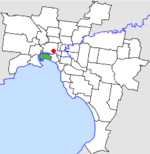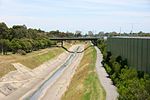Holden Fishermans Bend Plant
The Holden Fishermans Bend Plant[1] was a industrial park opened in 1936 in Fishermans Bend, Victoria, as Holden's headquarters. The new location was opened due to many issues with its previous City Road facility. The park was also intended to kickstart a Victorian leg of the General Motors subsidiaries Chevrolet and Vauxhall. In 1948, the plant facilitated the production of the first Holden-branded motor vehicle, the Holden 48-215. In 1956, due to an inability to meet demand, the assembly section of the plant was closed, succeeded by the new Dandenong plant. The Fishermans Bend plant also produced engines and driveline components for all domestic and most exported vehicles up until 2016, when the Australian LFX V6 was discontinued. In 1981, production started of the global Family II engine series - most of which were produced for export to other GM plants around the world. Since 2020, the area is no longer used by Holden for manufacturing or administration. In 2021, it was announced that the University of Melbourne planned to redevelop the area as the headquarters of its school of engineering, with plans to open in 2024.
Excerpt from the Wikipedia article Holden Fishermans Bend Plant (License: CC BY-SA 3.0, Authors).Holden Fishermans Bend Plant
Salmon Street, Melbourne Port Melbourne
Geographical coordinates (GPS) Address Nearby Places Show on map
Geographical coordinates (GPS)
| Latitude | Longitude |
|---|---|
| N -37.82477 ° | E 144.92156 ° |
Address
Salmon Street 189-219
3207 Melbourne, Port Melbourne
Victoria, Australia
Open on Google Maps






